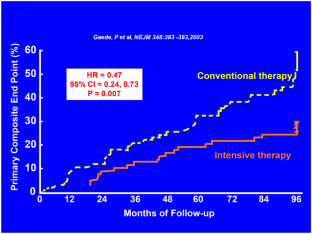Current Cardiology Reports ( IF 3.7 ) Pub Date : 2024-04-18 , DOI: 10.1007/s11886-024-02055-0 Sivaram Neppala , Jemema Rajan , Eric Yang , Ralph A. DeFronzo

|
Purpose of Review
What is new? Cardiovascular disease (CVD) is the leading cause of mortality in type 2 diabetes (T2D) individuals. Of the major risk factors for CVD, less than 10% of T2D people meet the American Diabetes Association/American Heart Association recommended goals of therapy. The present review examines how much of the absolute cardiovascular (CV) risk in type 2 diabetes patients can be explained by major CV intervention trials.
Recent Findings
Multiple long-term cardiovascular (CV) intervention trials have examined the effect of specific target-directed therapies on the MACE endpoint. Only one prospective study, STENO-2, has employed a multifactorial intervention comparing intensified versus conventional treatment of modifiable risk factors in T2D patients, and demonstrated a 20% absolute CV risk reduction.
Summary
If the absolute CV risk reduction in these trials is added to that in the only prospective multifactorial intervention trial (STENO-2), the unexplained CV risk is 44.1%.
What are the clinical implications?
-
Potential explanations for the unaccounted-for reduction in absolute CV risk in type 2 diabetes (T2D) patients are discussed.
-
Hypothesis: failure to take into account synergistic interactions between major cardiovascular risk factors is responsible for the unexplained CV risk in T2D patients.
-
Simultaneous treatment of all major CV risk factors to recommended AHA/ADA guideline goals is required to achieve the maximum reduction in CV risk.
中文翻译:

2 型糖尿病中无法解释的残留风险:问题有多大?
审查目的
有什么新内容?心血管疾病 (CVD) 是 2 型糖尿病 (T2D) 个体死亡的主要原因。在 CVD 的主要危险因素中,只有不到 10% 的 T2D 患者达到美国糖尿病协会/美国心脏协会推荐的治疗目标。本综述探讨了 2 型糖尿病患者的绝对心血管 (CV) 风险在多大程度上可以通过主要的 CV 干预试验来解释。
最近的发现
多项长期心血管 (CV) 干预试验研究了特定靶向治疗对 MACE 终点的影响。只有一项前瞻性研究 STENO-2 采用多因素干预措施,比较了 T2D 患者可改变危险因素的强化治疗与常规治疗,并证明绝对 CV 风险降低了 20%。
概括
如果将这些试验中的绝对 CV 风险降低添加到唯一的前瞻性多因素干预试验 (STENO-2) 中,则不明原因的 CV 风险为 44.1%。
有什么临床意义?
-
讨论了 2 型糖尿病 (T2D) 患者绝对心血管风险不明原因降低的潜在解释。
-
假设:未能考虑主要心血管危险因素之间的协同相互作用是导致 T2D 患者出现无法解释的心血管风险的原因。
-
需要根据推荐的 AHA/ADA 指南目标同时治疗所有主要 CV 风险因素,以最大限度地降低 CV 风险。



























 京公网安备 11010802027423号
京公网安备 11010802027423号